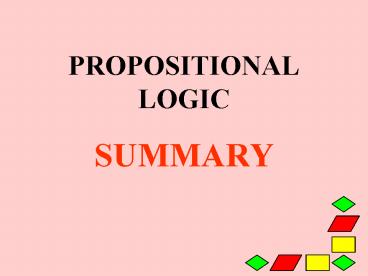PROPOSITIONAL LOGIC
1 / 30
Title: PROPOSITIONAL LOGIC
1
PROPOSITIONAL LOGIC
- SUMMARY
2
DEFINITIONS
- A declarative sentence is a sentence that
declares a fact or facts. - A proposition is a declarative sentence to which
we can assign a truth value of either true or
false, but not both. - Logical Variables are letters such as p, q, r,
s, or A, B, C, D, that are used to represent
propositions
3
MORE DEFINITIONS
- Connectives are symbols or words that enable you
to combine simple propositions to form compound
propositions. - Propositional form is an expression involving
logical variables and connectives such that, if
all variables are replaced by propositions then
the form becomes a proposition. - Truth tables assign truth-values to propositional
forms when truth-values have been assigned to the
variables in the form.
4
EXAMPLES OF A DECLARATIVE SENTENCE
- The earth is round.
- 5 2 6 1
- 1 0
- This sentence is false.
5
EXAMPLES OF A PROPOSITION
- The earth is round. IS TRUE
- 5 2 6 1 IS TRUE
- 1 0 IS FALSE
- This sentence is false. IS NOT A
PROPOSITION
6
TRUTH TABLES
- Truth tables are constructs that show the
resulting value of two propositions and a logical
operator being joined together to form a more
complex proposition.
7
TRUTH TABLES
- Truth tables are constructs that show the
resulting value of two propositions and a logical
operator being joined together to form a more
complex proposition. - Each proposition listed in a truth table will
have a value of either true or false, which will
allow for a possibility of four combinations.
When combined with logical operators, or
connectives, the resulting value of the
combination changes
8
CONNECTIVES
- AND (Ù)
- The and connective joins propositions together in
such a way that the result is true ONLY if the
value of both propositions is true.
9
CONNECTIVES
- OR (Ú)
- The or connective joins propositions together in
such a way that the result is true if either
proposition has a true value.
10
CONNECTIVES
- NOT (Ø)
- The not operator is a little different. It only
works on one proposition at a time, whether that
proposition is a single entity, or the result of
another operation. The not operator "negates" the
given result.
11
CONNECTIVES
- EXAMPLE OF A CONJUNCTION
- P This book is boring.
- Q I am hungry.
- And
- PQ This book is boring and I am hungry.
12
CONNECTIVES
- EXAMPLE OF A DISJUNCTION
- P Linda is a secretary.
- Q Jim is lazy.
- v Or
- PvQ Linda is a secretary or Jim is lazy.
13
CONNECTIVES
- EXAMPLE OF IMPLICATION
- P It is Monday.
- Q We are in Italy.
- gt Implies
- PgtQ If it is Monday then we are in Italy.
14
CONNECTIVES
- EXAMPLE OF EQUIVALENCE
- P The world will blow up.
- Q CHAOS rules the world.
- ltgt Equivalence
- PltgtQ The world will blow up if an only if
- CHAOS rules the world.
15
NEGATION
- EXAMPLE OF NEGATION
- P I have two kittens.
- P I do not have two kittens.
16
LAW OF DETACHMENT
- (MODUS PONENS)
- P gt Q
- P
- _______________
- therefore Q
17
LAW OF THE CONTRAPOSITIVE
- P gt Q
____________ - therefore Q gt P
18
LAW OF MODUS TOLLENS
- P gt Q
- Q
- _______________
- therefore P
19
LAW OF SYLLOGISM
- (HYPOTHETICAL SYLLOGISM)
- P gt Q
- Q gt R
- _______________
- therefore P gt R
20
LAW OF DISJUNCTIVE INFERENCE
- (DISJUNCTIVE SYLLOGISM)
- P v Q
- P
- __________
- Q
- P v Q
- Q
- ________
- therefore P
21
LAW OF THE DOUBLE NEGATION
- (P)
____________ - therefore P
22
DeMORGANS LAW
- (P Q) (P v Q)
___________
___________ - therefore P v Q therefore P Q
23
LAW OF CONJUNCTION
- P
- Q
____________ - therefore P Q
24
LAW OF DISJUNCTIVE ADDITION
- P
____________ - therefore P v Q
25
LAW OF CONJUNCTIVE ARGUMENT
- (P Q) (P Q)
- P
Q
___________
___________ - therefore Q
therefore P
26
REASONING WITH PROPOSITIONAL LOGIC
If theres a fire there will be smoke. If there
is smoke there will be an alarm. Can we count on
hearing an alarm if there is a fire?
27
TAUTOLOGICAL FORM
- (MODUS PONENS)
- P (P gt Q) gt Q
28
TAUTOLOGICAL FORM
- (MODUS TOLLENS)
- Q (P gt Q) gt P
29
TAUTOLOGICAL FORM
- HYPOTHETICAL SYLLOGISM
- (P gt Q) (Q gt R) gt P gt R
30
TAUTOLOGICAL FORM
- DISJUNCTIVE SYLLOGISM
- (P V Q) P gt Q































